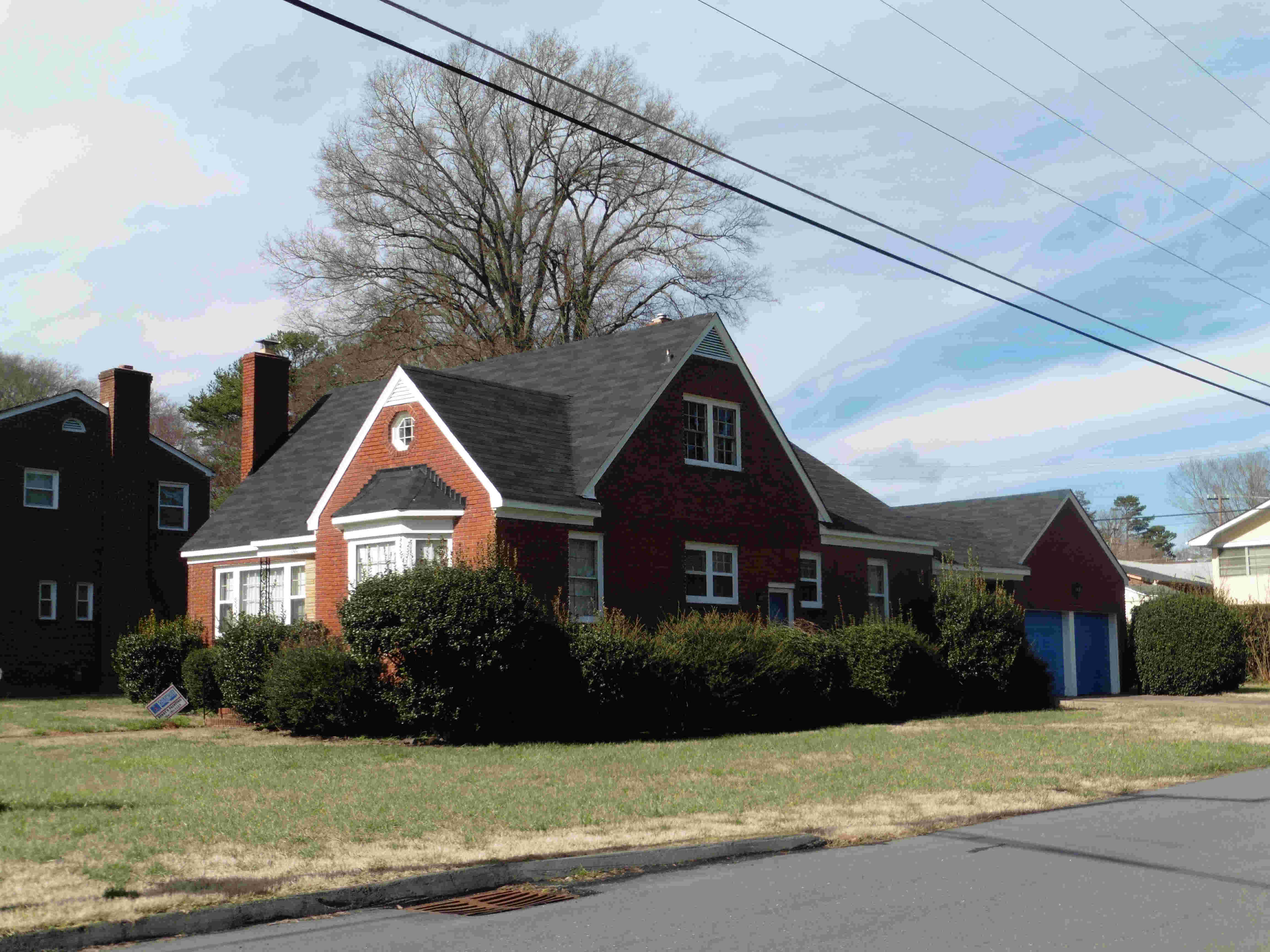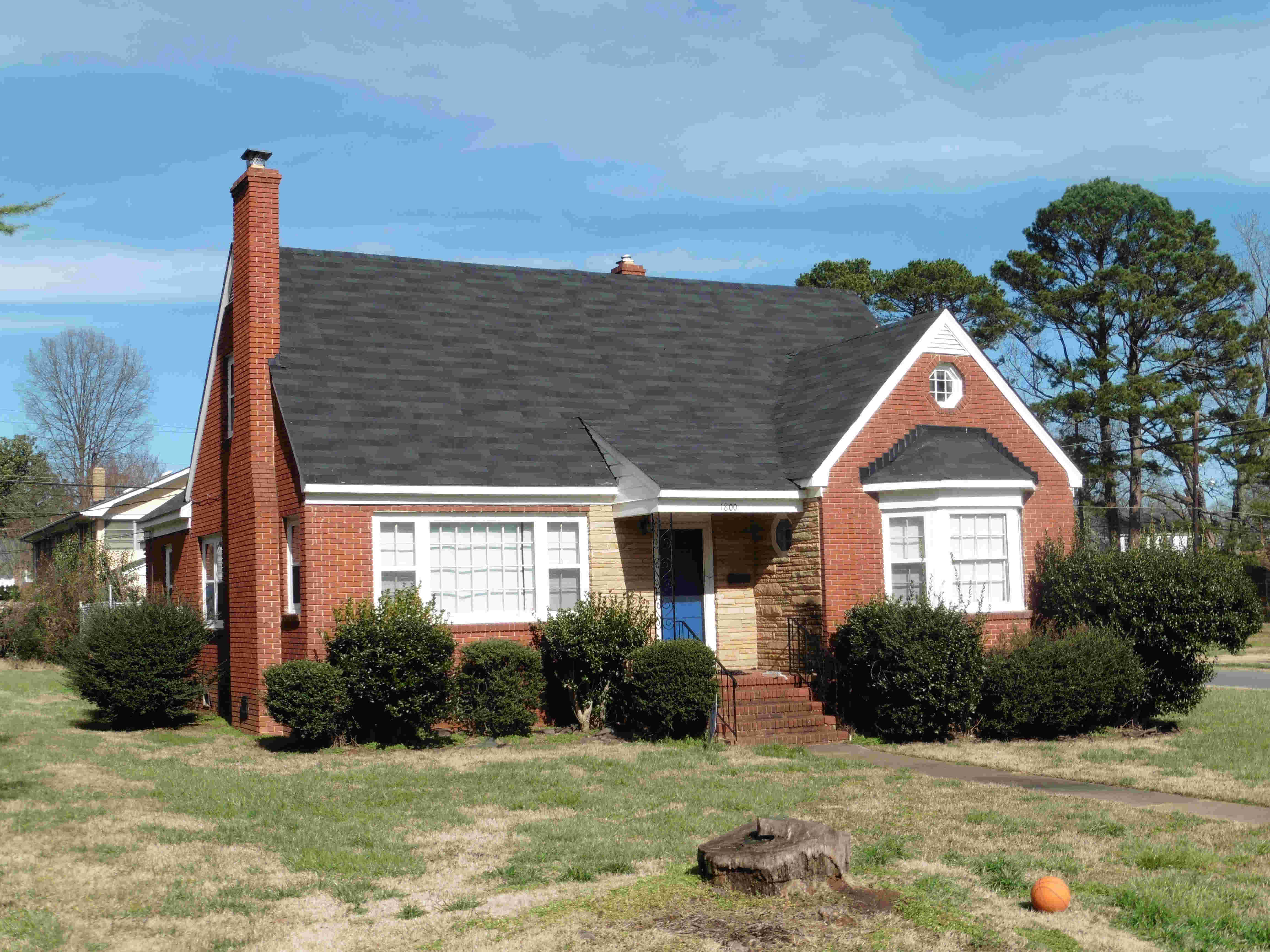1800 Madison Avenue
 Built 1953-54 for Dr. Edwin Thompkins and his wife Roberta. He was a JCSU religion professor known for his academic attainments and for his Civil Rights activism. In September 1957 he accompanied young Dorothy Counts as she walked through an angry mob to desegregate Harding High School, a moment captured in photos that appeared in newspapers nationwide.
Built 1953-54 for Dr. Edwin Thompkins and his wife Roberta. He was a JCSU religion professor known for his academic attainments and for his Civil Rights activism. In September 1957 he accompanied young Dorothy Counts as she walked through an angry mob to desegregate Harding High School, a moment captured in photos that appeared in newspapers nationwide.
* * *
Educated at Johnson C Smith, Thompkins went on to earn a masters in Theology at Western Theological Seminary in Pennsylvania (Class of ’39), operated by the Reformed branch of the Presbyterian Church, then an MA in Education and a PhD from University of Pittsburgh. For his doctoral research he wrote a history of “Presbyterian Religious Education Among Negroes” published in the denomination’s journal in 1951 which remains a useful resource today.
From the moment he joined Johnson C. Smith University’s School of Theology as a teacher in 1939, Thompkins was a key man on campus. For one thing, few staff members at JCSU held PhDs, so Thompkins’ research and writing ensured respect. For another, his energy helped bolster the school’s Theological Seminary, small and not well-funded, but central to JCSU’s mission as a Presbyterian-founded college. When longtime dean Arthur George retired in 1960, Dr. Thompkins moved up to become Dean of Theology, the second-ranking administrator at the University.
He became well-known in national Presbyterian circles. In the 1960s he served as Moderator (chief lay leader) of the church’s Catawba Synod, the governing body that covered North Carolina and Virginia. When the denomination’s Department of Historical Research and Conservation, with its archive in Philadelphia, began to integrate its leadership in the 1970s, Dr. Thompkins was the first African American male named to the board.
Thompkins put his faith into practice in his community. Two examples — one of which received national attention, the other largely unknown — indicate his courage during the Civil Rights Movement.
The first episode occurred during the integration of Charlotte schools in 1957. Pushed by the 1954 Brown v Board Supreme Court ruling that outlawed school desegregation, Charlotte’s Board of Education gingerly admitted four African American students to four white schools. The media flash point came when Dorothy Counts, fifteen year old daughter of JCSU Professor Herman Counts, walked into Harding High School on September 4, 1957. Dr. Reginald Hawkins of the NAACP and family friend Dr. Edwin Thompkins volunteered to accompany her. Hawkins drove the trio in his car, dropped Counts and Thompkins off near the school and went to park. Young Dorothy with Thompkins by her side strode resolutely toward the school steps as white students began to jeer, then spit. Photographers Don Sturkey and Douglas Martin, among others, caught the ugly mob on film. Martin’s image of Counts next to grim-faced but resolute Thompkins won Photo of the Year in the annual World Press Photo awards. Don Sturkey’s photograph was picked up by the International Herald Tribune. The famed African American essayist James Baldwin later recalled seeing it in Paris: “On every newspaper kiosk on that wide, tree-shaded boulevard in Paris were photographs of 15-year-old Dorothy Counts being reviled and spat upon by the mob as she was making her way to school in Charlotte, N.C. There was unutterable pride, tension and anguish in that girl’s face as she approached the halls of learning with history jeering at her back. It made me furious.” It became one reason that James Baldwin came home to the U.S. and dove into Civil Rights activism. The photo and Baldwin’s comments again got national play in 2016-17 when they led off a feature film about Baldwin: I Am Not Your Negro.
Dr. Thompkins’ other show of Civil Rights courage came three years later in 1960. That fall Thompkins purchased a house at 1536 Merriman Avenue in the all-white Wilmore neighborhood. Dr. Thompkins was light-skinned and able to pass for white. He did not mention his race to the seller, William Simpson, who assumed that Thompkins was white. When word got around that an African American had made the purchase, neighbors reacted with violence toward Simpson. “Saturday night four shots ripped into Simpson’s home,” reported a United Press story that appeared in newspapers as far away as California. Simpson, his pregnant wife and their two children escaped injury, but “none of his ‘friends’ in the neighborhood would have anything to do with the family since the sale.” There must have been some sleepless nights in McCrorey Heights, as well, as Dr. Thompkins and his family feared further retaliation at their own home. Thompkins issued a statement that he would rent the Wilmore house — to a white tenant — but he made no move to give up ownership.
Thompkins’ wife Roberta was a life-long educator, as were most of the wives in McCrorey Heights during the 1950s and 1960s. She grew up in Charlotte, the daughter of Dr. Robert L. Douglass, a mathematics professor at Biddle / JCSU from 1904 to 1947. Dr. Douglass hailed from Fairfield County in South Carolina, which was also the birthplace of JCSU president H.L. McCrorey; perhaps coincidentally the Thompkins house stood at the corner of Fairfield Street in McCrorey Heights. Roberta Douglass Thompkins graduated from JCSU and Columbia University, then taught at Fairview Elementary and Marie G. Davis Elementary.
Both Dr. and Mrs. Thompkins were active in the life-long fraternity/sorority organizations that were so important to well-educated African Americans. He was a member of Alpha Phi Alpha fraternity, an affiliation he shared with JCSU president Rufus Perry, and he served as president of the Charlotte chapter in the early 1960s. She belonged to Delta Sigma Theta and also was active in McCrorey Heights’ own women’s social club The Moles.


Architecture
Cottage style residence, 1.5 stories tall in red brick. It has a high gabled main roof, which hides the second story. A gabled wing extends at the front, with a round window in the gable and a projecting bay window below. A small, curved shed roof shelters the front door, which is accented by stonework. Note the large, horizontal three-part “picture window” in the living room and the prominent exterior chimney on the west side of the house. A hip-roofed section completes the rear of the house.
The dwelling is located on a prominent corner lot, its front facing Madison Avenue and side (including a rear gabled wing that holds a two-car garage) facing Fairfield Street.
Constructed by Mangie McQueen, a McCrorey Heights neighbor who was one of Charlotte’s busiest African American building contractors.
Building permits
Madison 1800 permit d
Date issued: August 15, 1956
Owner: Thompson
Contractor: Beam Electric Co.
Estimated cost:
Other permit info:
Madison 1800 permit b
Date issued: September 10, 1962
Owner: Edwin Tompkin
Contractor: Mangie McQueen
Estimated cost: $500
Other permit info: re-roof residence
Madison 1800 permit c
Date issued: June 23, 1958
Owner: Edwin Thompkin
Contractor: Quality Electric Co.
Estimated cost:
Other permit info: Install 26 outlets, 3 fixtures
Madison 1800 permit a
Date issued: June 13, 1973
Owner: Edwin Tompkins
Contractor: Mangie McQueen
Estimated cost: $325
Other permit info: Remodel garage
Madison-1725-permit-c
Date issued: June 26, 1953
Owner: Dr. Edwin Thompkins
Contractor: Mangie McQueen
Estimated cost:
Other permit info:
First appeared in city directory
1956 – Edwin Thompson [sic] & Roberta D.
He: Professor, JCSU
She: Teacher, Marie G. Davis Elem. Sch.
1982 city directory – Rev. Edwin Thompkins & Roberta D. He: retired. She: No occupation listed
Obituaries
Resources
“Alpha on Campus … Johnson C. Smith University,” Sphinx, Winter 1968. On-line at: https://issuu.com/apa1906network/docs/196805404/8
“Beta Nu Lambda News,” Sphinx, Winter 1962. On-line at: https://issuu.com/apa1906network/docs/196204804/33
“Director Raoul Peck: James Baldwin was ‘Speaking Directly to Me'” (transcript), NPR Fresh Air website. On-line at: http://www.npr.org/templates/transcript/transcript.php?storyId=515196224
“Dorothy Counts at Harding High: A Story of Pride, Prejudice,” Charlotte Observer, September 2, 2007. On-line at: https://www.charlotteobserver.com/news/local/article66900492.html
“Edwin Thompkins Succeeds Dr. Arthur George as Dean of Johnson C. Smith’s School of Theology,” Carolina Times, September 17, 1960. On-line at: http://newspapers.digitalnc.org/lccn/sn83045120/1960-09-17/ed-1/seq-10/#index=4&rows=20&proxtext=Edwin+Thompkins&searchType=basic&sequence=0&words=Edwin+Thompkins&page=1
“Henry Lawrence McCrorey,” Journal of Negro History, July 1952. On-line at: http://www.jstor.org/stable/2715507?seq=1#page_scan_tab_contents
“Four Bullets Are Fired into House,” Charlotte Observer, November 25, 1963.
“Negro Professor to Rent to Whites,” Daily Independent Journal, November 28, 1963. On-line at: https://www.newspapers.com/image/71945402/
“News, First Prize Singles: Douglas Martin, 4/9/57,” WorldPressPhoto.org website. On-line at: https://www.worldpressphoto.org/collection/photo/1957/spot-news/douglas-martin
Rainey, Virginia F., Stewards of Our Heritage: A History of the Presbyterian Historical Society (Geneva Press, 2002), pp. 108 – 110.
Thompkins, Robert Edwin, “Presbyterian Religious Education Among Negroes,” Journal of the Presbyterian Historical Society, 1951.
Thompkins, Roberta, funeral program in the History Room, First United Presbyterian Church, Charlotte.